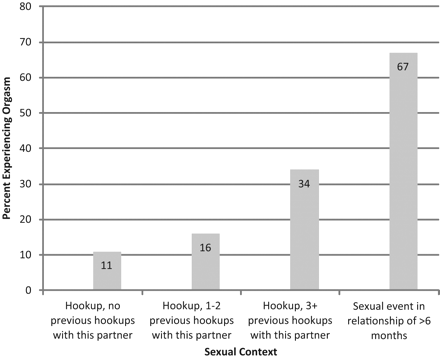
One of the most wondered questions in the study of human evolution is, whether or not the female orgasm has an adaptive function. The female orgasm contains subjective feelings of pleasure and relief of sexual climax, as well as physiological processes, such as heavy breathing and high blood pressure (Meston, 2004). Additionally, the clitoris is the only human body part designed solely for pleasure. Based on studies involving female orgasm researchers have proposed different hypothesis and ideas explaining the adaptive role of a female orgasm.
According to Lloyd (2005), the female orgasm is a byproduct, which is a “secondary and sometimes unexpected or unintended result.” The female orgasm is a byproduct because females are almost genetically identical to males. Genetic factors may produce an adaptation in males, whereas in females it may produce a non-adaptive byproduct, or vise versa (Lloyd, 2005). For example, according to Symons (1979) although nipples are an adaptive feature in women (breastfeeding), for men nipples are a non-adaptive byproduct because they do not have an adaptive function (as cited in, Puts,Dawood & Welling, 2012). Under the byproduct theory for female orgasm, the female orgasm exists because the male orgasm is an adaptation. In other words, an orgasm first appeared in man, but over time as men and women begun to have a similar genetic make up women developed the ability to orgasm. Furthermore, Symons (1979) states “female orgasm is too difficult to induce, and its expression too variable among women for it to be an adaptation (as cited in, Puts et al.,). However, research suggests that the time it takes for sibling pairs, including monozygotic and dizygotic twins and non-twin full siblings to orgasm is not positively correlated (Zietsch and Santtila, 2011). This study undermines the byproduct theory because if the theory were correct then siblings would be able to orgasm with the same ease.
In addition, in the mate choice theory, female orgasm is adaptive. The female orgasm’s main function is to operate for the purpose of selecting long-term, investing partners (pair-bond hypothesis) or for selecting high-quality sires for reproduction (sires choice hypothesis) (Puts et al.,). According to the pair-bond hypothesis, Puts et al., state, “if female orgasm function in mate choice, then the probability of a women achieving orgasm should depend, in part, upon the quality of her mate.” This could suggest that investing men are more prone to induce orgasm in women; an orgasm may bond women to men. Furthermore, women’s difficulty in obtaining an orgasm may indicate a function in selecting and securing a long term, investing partner. Additionally, studies found a correlation between orgasm and foreplay (Singh, Meyer, Zambarano & Hurlbert, 1998). This may suggest that women with more attentive male partners are much more likely to reach orgasm. This may be considered a reproductive advantage for women because attentive men may invest more resources into raising children; so from an evolutionary prospective, female orgasm may have become an adaptation for choosing caring male partners.
Furthermore, after an orgasm, in both in men and women, extremely high levels of oxytocin are released into the body (Kruger, Hakke, Chereath, Knapp & Johnson, 2003). Oxytocin is a hormone that is known to have prosocial effects (Kirsch et al., 2005) and researchers found evidence to suggest that oxytocin may mediate human pair bonding, especially in women (Heinrich, von Dawans & Domes, 2009). Strong bonds between men and women may have been essential, especially for a man, because it may have assured him that he is the biological father of his children, assuming that a woman with a strong bond to her male partner is less likely to cheat. Although in both men and women, love and high oxtocin levels are correlated, only women experience physical benefits such as lower blood pressure and cortisol levels, suggests that oxytocin levels may be more prominent in women and its effects larger (Heinrich et al.,2009). Conversely, undermining the pair-bond hypothesis, women’s orgasm rate is lowest in marriage and highest in a relationship that is less thethanree months (Laumann, Gagnon, Michael, Michaels, 1994). Further, research conducted by Thornhill, Gangestad and Corner (1995) suggests female orgasm is not associated with love or relationship duration (as cited in, Puts et al.)
The sire choice hypotheses is another variation of the mate choice theory, Puts et al., (2011) state, according to the sire choice hypotheses, “female orgasm has evolved to select among copulatory partners, then the choosiness of female orgasm should be most characteristic of copulation.” This would suggest that women should be less likely to orgasm via masturbation because it is not involved in mate selection. Conversely, female orgasm is more easily attained via masturbation (Baker and Bellis, 1993). Additionally, according to Baker and Bellis (1993) if female orgasm operates according to the sire choice hypothesis, then women should experience more orgasms with males of excellent genetic quality. According to research, only partner’s attractiveness forecasted female orgasm (Shackrlford et al. 2000). Although this may indicate that attractive men are more likely to give women orgasms, it was a correlation study, so women may have rated their partner’s physical attractiveness high, because those women were obtaining constant orgasms from their partner.

Additionally, the sire choice hypothesis may offer an explanation to the phenomenon of women faking orgasm. Although women may orgasm less with men of poor genetic quality, women may fake orgasms with these men to, misleadingly, send them a message that these men were being chosen as sires (Puts et al., 2011). Roughly, 60% of women reported faking an orgasm at sometime in their life (Muehlenhard & Shippe, 2009) and according to Theornhill et al. (1995), women reported faking an orgasm 13% of the time with their long term partner. If the sire choice hypothesis were correct, then women are more likely to fake an orgasm with a long-term partner that has poor generic qualities, because women want to acquire a long-term investment in resources from their partner. In addition, women who fake orgasms with their long-term partner may also be more likely to cheat on their partner with men who have better quality genes (Puts et al., 2012). In addition, women who suspect infidelity are more likely to fake an orgasm (Puts et al., 2012). This may suggest that cheating partners may become less attractive to women, or it may suggest that women who are not necessarily physically attracted to their cheating partner are fighting to secure their male partner from another mate, so not to loss their partner’s invested resources.
According to Plutchik (1980) the female orgasm has an adaptive function because of its reward value; the pleasure a woman may get during an orgasm may motivate her to have more sex (as cited in, Puts et al., 2012).The more sex a woman has, possibly, the more likely she is to reproduce. Furthermore, research suggests that women are pleasure oriented not goal oriented (Jabbini et al, 2012). This pleasure principle may explain the adaptive purpose of the clitoris, which is the primary source of female sexual pleasure (Jannini et al, 2012). Although researchers knew about the clitoris being a source of female pleasure for many years, it was only in 1950 that another source for female sexual pleasure, the G-spot, was identified by Ernst Grafenberg (Kilchevsky, Vardi, Lowenstein, Grunwald, 2012). Ernst Grafenberg described the G-spot as a “1-2 cm area on the front wall of the vagina close to the bladder and urethra, about halfway between the pelvic bone and the cervix…which in some women was especially sensitive to direct mechanical stimulation” (as cited in, Kilchevsky et al, 2012). Researchers believe the female G-spot is associated with virginally activated orgasm (Jannini et al.,2012). Virginally activated orgasm may reinforce women to have vaginal intercourse, which is essential for human reproduction.
Moreover, emotional intelligence in women is associated with their ability to orgasm (Burri, Cherkas & Spector, 2009). This may suggest that female orgasm is adaptive, but its function may not be to help women choose a male partner, instead, its function may be to help men choose a female partner. The five components of emotional intelligence: self-awareness, ability to know your own emotions; self-regulation, ability to manage your emotions in stressful situations; empathy, ability to read a person’s emotions and sympathize; social skill, ability to interact well with others; lastly, motivation, ability to turn negative situations into positive situations (Heather, 2010). Additionally, the qualities men reported they want in a female partner are confidence, spontaneity, good humor, compassionate, and composed (McIntyre, 2010). This may suggest that the components of emotional intelligence in women may be associated with the qualities men are looking for in women. It may be adaptive for men to discover these qualities in a female partner before rendering resources. Consequently, female orgasm maybe a way for men to determine if a female partner posses the desired qualities for a long term relationship, before rendering resources.
The age-old question: is the female orgasm an adaptive function? Although researchers have proposed various theories, researchers are unable to give a definitive answer. However, research has expanded our overall knowledge of the female orgasm and has presented us with interesting ideas and approaches for further study. For a future study, it would be interesting to study women’s attachment styles to their male partner and the number of orgasms they receive. It is indeed possible the function of the female orgasm will continue to puzzle researchers for many years to come.